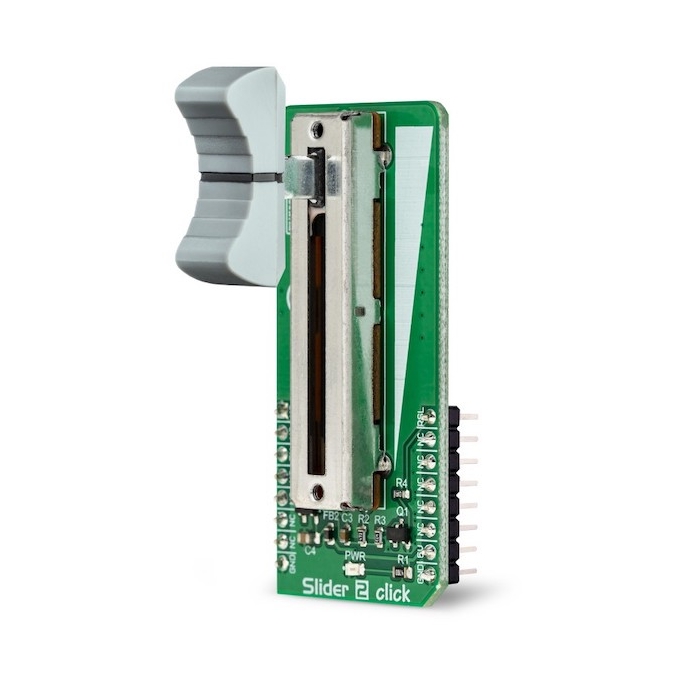MIKROE Slider 2 Click
The Slider 2 Click is a very accurate potentiometer Click board™, featuring a high-quality mechanical slide-action potentiometer (slider).
Product Overview
The Slider 2 Click is a very accurate potentiometer Click board™, featuring a high-quality mechanical slide-action potentiometer (slider), which in conjunction with the accurate voltage reference IC, provides very precise analog control voltage (CV) at its output. Featuring an accurate voltage reference IC, the output of the Click board™ can be directly sampled by the A/D peripheral of the microcontroller (MCU). Since there are many different MCU architectures with different reference voltage requirements, Slider 2 Click offers a possibility to select the voltage reference between 4.096V and 2.048V, two most commonly used values for different MCU peripherals.
The output from the potentiometer is buffered by the high-performance rail-to-rail operational amplifier, which ensures clean and low-noise signal to the VO pin of the Click board™. Featuring a very accurate voltage reference and a high-quality 30 mm slider, this Click board™ can be used in any application that requires an analog control voltage, or it can be used to build HMI applications, adding them an accurate slider potentiometer.
The Slider 2 Click utilizes the PTA3043, a linear, high-grade, 10K potentiometer made by Bourns. This potentiometer has a 30 mm travel distance. The long travel distance of the wiper allows more accurate movements and combined with the high-quality manufacturing process it allows to dial-in the desired voltage with ease. This type of potentiometers are also known as sliders, thus the name for this Click board™. The potentiometer has a small dent in the middle, which enables tactile feedback when the center position is reached. The potentiometer is connected between the VREF and GND, acting as a voltage divider. Its wiper terminal outputs voltage in the range from 0 to 4.096V, depending on its position. The used potentiometer is linear, so the wiper potential changes linearly with its position.
The voltage reference(VREF) is obtained from the MCP1501, a high-precision voltage reference IC from Microchip. The main purpose of this IC is to provide and retain a very accurate voltage of 4.096V. Its voltage reference is accurate enough for most applications where the analog output from the Slider 2 Click can be utilized as a control voltage signal (CV). The output is buffered with a rail-to-rail, low-power operational amplifier, labeled as OPA344, produced by Texas Instruments. After the buffering op-amp, the output signal is delivered at the AN pin of the mikroBUS, labeled as VO on this Click board™, so it can be easily sampled by the internal A/D converter of the host microcontroller unit (MCU.
Most MCUs have A/D peripherals that can use 4.096 as the reference voltage for the full-scale value (PIC 8-bit family is a good example). However, there are many cases where 2.048V is more adequate, so the Click board™ offers a choice: if there is a HIGH logic level at the RSL pin, the N-type MOSFET will open and another resistor will be introduced to the circuit. A voltage divider will be formed at the input of the buffering op-amp, which will halve the voltage from the potentiometer, reducing its maximum value to 2.048V. When the logic level at the RSL pin is LOW, the N-type MOSFET will stay closed, so the second resistor of the voltage divider remains isolated. This will cause the full voltage level from the potentiometer to appear at the VO pin of the Click board™, in the range from 0 to 4.096V max.
The MCP1501 IC has the #SHDN pin, used to shut down the IC when it's set to a LOW logic level. When this pin is set to a LOW logic level, the voltage reference output will be turned OFF, so there will be no voltage changes at the VO pin. By enabling the MCP1501 the voltage reference is established once again, so the Click board™ can deliver an analog signal with the voltage ranging from 0 to 4.096V, or from 0 to 2.048V if the RSL pin is set to a HIGH logic level. It is recommended to start up the Click board™ with the EN pin at the LOW logic level, to allow the internal power supply of the MCP1501 to reach its operational values.
Features & Specs
- Interface: Analog, GPIO
- Compatibility: mikroBUS™
- Dimensions: 57.15 x 25.4mm
- Input Voltage: 5V
Documentation
Customer Reviews

Stock and Customer Discounts
Available Discounts
- $18.95 | 25+ units
- $17.96 | 100+ units
















